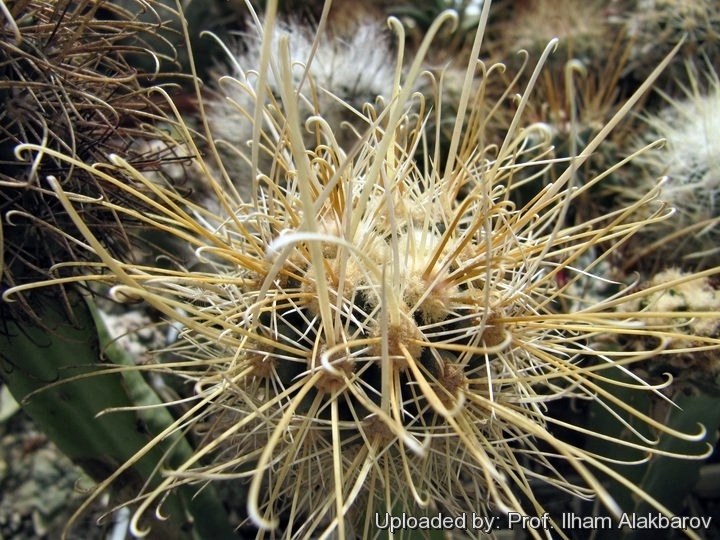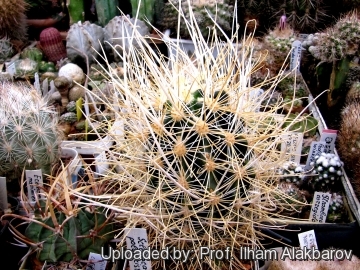Accepted Scientific Name: Sclerocactus polyancistrus (Engelm. & J.M.Bigelow) Britton & Rose
Cactaceae (Britton & Rose) 3: 213, pl. 23. 1922 [12 Oct 1922] Britton & Rose

Sclerocactus polyancistrus f. albispinus Photo by: Prof. Ilham Alakbarov
Origin and Habitat: Sclerocactus polyancistrusSN|19506]]SN|19506]] f. albispinus (white spined form) is reported from Searles, Kern Co., California, USA. White spined plants are somewhat rare however some white specimens occurs naturally throughout its range, and can be encountered in many populations.
Synonyms:
See all synonyms of Sclerocactus polyancistrus
back
Accepted name in llifle Database:Sclerocactus polyancistrus (Engelm. & J.M.Bigelow) Britton & RoseCactaceae (Britton & Rose) 3: 213, pl. 23. 1922 [12 Oct 1922]Synonymy: 5
back
Description: Sclerocactus polyancistrusSN|19506]]SN|19506]] is easily recognized by its big stem size (the giant of the genus), by numerous hooked, dense, central spines (five to nine) clothing and obscuring stems in a colourful assortment of red and white spines and large flowers with spicy, pungent odour.
White spined form: The white spined form (Sclerocactus polyancistrusSN|19506]]SN|19506]] f. albispinus) is easily recognizable from the standard species for its pure white central spines. White spined plants are somewhat rare, however some white specimens occurs naturally throughout its range, and can be encountered in many populations. The whiter forms are often very pretty and appreciated by collectors.
Stem: Single or in clusters, cylindric or more or less elongate, 10-40 long, 5-9 cm across.
Ribs: 13-17.
Spines: Dense, obscuring stems.
Radial spines: 10-18 per areole, white, straight, flat, 20-50 mm long.
Central spines: 9-12 per areole, 5-8 hooked, white, some hooked, 30-100 mm long. Adaxial central spines usually 3 per areole, white, usually curved or twisted, flat, usually 35-130 mm long.
Flower: With spicy pungent odour, funnelform, 5-10 cm in diameter outer perianth segments with greenish purple midstripes, inner segments rose-purple to magenta (rarely white).
Blooming season: April to June.
Fruit: Green, tan, or red, barrel-shaped, 2,2-5 cm, dry at maturity;
Remarks: S. polyancistrus is the only component of the genus that lacks papillae on the style, and its style possesses grooves, somewhat reminiscent of Ferocactus.
Subspecies, varieties, forms and cultivars of plants belonging to the Sclerocactus polyancistrus group
Bibliography: Major references and further lectures
1) Butterworth, C. & Porter, J.M. 2013. Sclerocactus polyancistrus. In: IUCN 2013. "IUCN Red List of Threatened Species". Version 2013.2. <www.iucnredlist.org>. Downloaded on 06 April 2014.
2) Edward Anderson “The Cactus family” Timber Press, Incorporated, 2001
3) James Cullen, Sabina G. Knees, H. Suzanne Cubey "The European Garden Flora Flowering Plants: A Manual for the Identification of Plants Cultivated in Europe, Both Out-of-Doors and Under Glass" Cambridge University Press, 11/Aug/2011
4) David R Hunt; Nigel P Taylor; Graham Charles; International Cactaceae Systematics Group. "The New Cactus Lexicon" dh books, 2006
5) Lyman David Benson “The Cacti of the United States and Canada” Stanford University Press, 1982
6) Fritz Hochstätter "An den Standorten von Pediocactus und Sclerocactus" Selbstverlag, 1989.
7) Fritz Hochstätter “The Genus Sclerocactus”. Selbstverlag, 2005
 Sclerocactus polyancistrus f. albispinus Photo by: Prof. Ilham Alakbarov
Sclerocactus polyancistrus f. albispinus Photo by: Prof. Ilham AlakbarovSend a photo of this plant.The gallery now contains thousands of pictures, however it is possible to do even more. We are, of course, seeking photos of species not yet shown in the gallery but not only that, we are also looking for better pictures than those already present.
Read More... Cultivation and Propagation: This is one of the most beautiful cacti but also one of the more difficult to be cultivated.
Very easily rot! Only few people have tried for long time to cultivate it, usually after a few months the plant inexorably dies.
It’s thought that’s better to watch this species in photo or in the natural habitat rather than to try to cultivate it.
For this reasons the plant is usually grafted on a frost hardy stock.
This plant need full sun and a very good ventilation, especially in winter.
Propagation: Seeds are extremely difficult to germinate (only 2-3 percent of seeds germinate) The germination is really difficult and if some seedling finally sprout, as they start to grows they disappear one by one. Grafting is often used to speed growth rate and to create a back-up for plants in collection.











